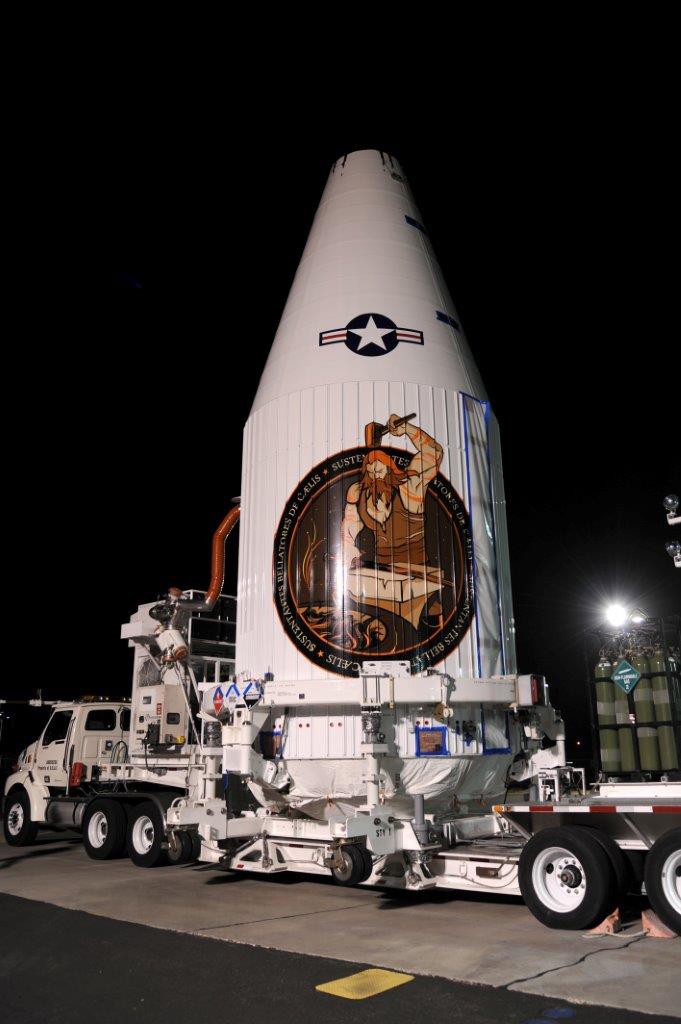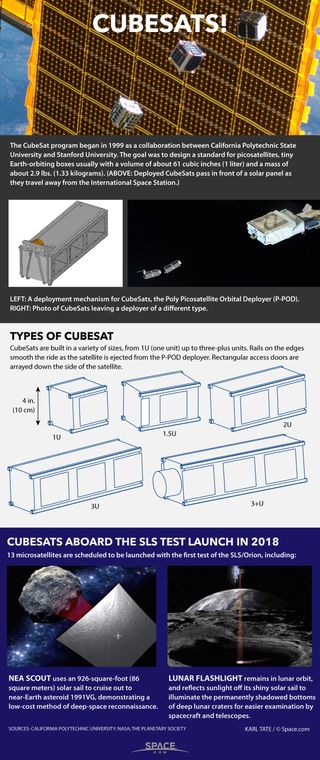
An American spy satellite will blast off early Thursday morning (Oct. 8), taking 13 tiny "cubesats" along for the ride, and you can watch all the action live.
A United Launch Alliance Atlas V rocket is scheduled to launch the NROL-55 mission for the National Reconnaissance Office (NRO), the agency that operates the United States' spy satellites, at 8:49 a.m. EDT (1249 GMT) Thursday from Vandenberg Air Force Base in California. You can watch the launch live on Space.com beginning at 8:29 a.m. EDT (1229 GMT), courtesy of NASA TV.
NROL-55's primary payload is classified, but the 13 cubesats — which will hitch a ride as part of the NRO's GRACE (Government Rideshare Advanced Concepts Experiment) secondary payload — are less mysterious. Nine of the bantam spacecraft are sponsored by the NRO, while the other four are sponsored by NASA. [Cubesats: Tiny, Versatile Spacecraft Explained (Infographic)]
Three of the NRO cubesats are part of a project called SNaP-3, "whose mission is to develop user software-defined radios to provide beyond-line-of-sight communication for disadvantaged users in remote locations," according to an NRO fact sheet. Each of the SNaP-3 spacecraft weighs 10 lbs. (4.5 kilograms).
Two other NRO cubesats from a project known as SINOD-D, which weigh just 4.4 lbs. (2 kg) apiece, will also demonstrate software-defined radio communications, while the 3.3-lb. (1.5 kg) AeroCube-5c and AeroCube-7 craft will prove out tracking and optical-communications technologies, according to the fact sheet.
The other two NRO cubesats, from the PropCube project, weigh a mere 2.2 lbs. (1 kg) apiece. This duo will perform calibration measurements high up in Earth's atmosphere.

The four NASA-sponsored cubesats are called ARC-1 (Alaska Research CubeSat 1), BisonSat, AMSAT Fox-1 and LMRST-Sat (Low Mass Radio Science Transponder-Satellite).
Get the Space.com Newsletter
Breaking space news, the latest updates on rocket launches, skywatching events and more!
ARC-1, which weighs 2.2 lbs., was developed by the University of Alaska Fairbanks. This miniature spacecraft will characterize the thermal and vibration conditions experienced during launch and help test out new cubesat control and communications systems.
Students at Salish Kootenai College, a tribal institution on the Flathead Indian Reservation in Montana, developed the 2.2-lb. BisonSat, which will perform a variety of Earth observations. A main goal of the project is to help students learn how to design, build and operate spacecraft, according to NRO officials.
The 2.2-lb. AMSAT Fox-1 was developed by the Maryland-based Radio Amateur Satellite Corp. (AMSAT). This cubesat "features an amateur radio FM voice repeater that will provide easy, portable satellite communications opportunities for amateur radio operators worldwide," the NRO fact sheet states.
A team based at NASA's Jet Propulsion Laboratory in Pasadena, California, devised LMRST-Sat, a 6.6-lb. (3 kg) spacecraft designed to demonstrate a new type of transponder that could help cubesats navigate through deep space, far from Earth.
You can also watch the NROL-55 launch live at ULA's website, http://www.ulalaunch.com, starting at 8:29 a.m. EDT (1229 GMT).
Thursday's liftoff will be the 101st launch for ULA, a joint venture of Boeing and Lockheed Martin that was founded in December 2006. All 100 of ULA's launches to date have been successful.
Follow Mike Wall on Twitter @michaeldwall and Google+. Follow us @Spacedotcom, Facebook or Google+. Originally published on Space.com.
Join our Space Forums to keep talking space on the latest missions, night sky and more! And if you have a news tip, correction or comment, let us know at: community@space.com.

Michael Wall is a Senior Space Writer with Space.com and joined the team in 2010. He primarily covers exoplanets, spaceflight and military space, but has been known to dabble in the space art beat. His book about the search for alien life, "Out There," was published on Nov. 13, 2018. Before becoming a science writer, Michael worked as a herpetologist and wildlife biologist. He has a Ph.D. in evolutionary biology from the University of Sydney, Australia, a bachelor's degree from the University of Arizona, and a graduate certificate in science writing from the University of California, Santa Cruz. To find out what his latest project is, you can follow Michael on Twitter.
Most Popular

